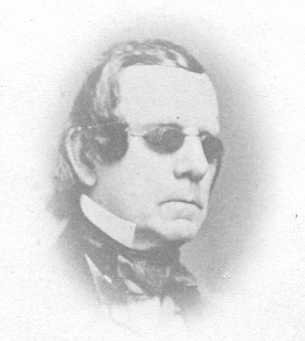Disclaimer
The Dover Public Library website offers public access to a wide range of information, including historical materials that are products of their particular times, and may contain values, language or stereotypes that would now be deemed insensitive, inappropriate or factually inaccurate. However, these records reflect the shared attitudes and values of the community from which they were collected and thus constitute an important social record.
The materials contained in the collection do not represent the opinions of the City of Dover, or the Dover Public Library.
William Gookin

This famous Dover artist lived here from 1830 to his death in 1873. For further evidence of Gookin’s activity at the mid-century point we have a series of notices placed in the Dover Gazette and Strafford Advertiser, in 1847, when Gookin was moving his studio. “Removal Portrait Painter” William S. Gookin has taken rooms in the Tetherly block, Central Square where he continues his business of portrait, landscaping and fancy painting. Also copy painting of every description. He has connected with his portrait painting the taking of Daguerreotype miniatures, having fitted up rooms for this purpose. It will be noted here that Gookin seemed aware of what the photographic arts were going to do to his business, and instead of fighting it, he adapted it to his own benefit.
One of Gookin’s specialties was painting life portraits after death. And some of his notices mentioned what good likenesses he was able to get.
Gookin did not paint in any one room attic, but instead “had quite an elaborate establishment. About 1861, Gookin moved into the Kingman block, where the Strafford bank was located. A Dover lady who visited his studio writes as follows: I remember being an accredited member of a local body of visitors to Gookin’s studio in the Kingman block, The rooms, two in number, were long and lighted from the north and south. There I saw in long rows, on narrow shelves, and on the floor loaned canvasses turned inward. Putting one after the other on an easel, Mr. Gookin led us courteously through the major part of the collection.
It is quite apparent that Mr. Gookin was actively painting in and around Dover, for almost 35 years. There must have been hundreds and hundreds of examples of his art in the homes of this area. Like most other painters of the period, Gookin signed practically none of his work.
Because Gookin never married and lived alone all of his many years in Dover, it might be assumed that he led a rather sad and lonely existence; but his does not seem to be the case. One Dover lady, had the following to day: “To begin with, he was a fine looking man, he was well informed and very good company. But he was one of those to whom we had to allow moods. When the sun shone he was full of redundant life, and when the vapors arose he sat in the shade. He was a very worthy person. Most people did not appreciate him at his true worth, until after his death.” Mr. John Abbott, once an important figure on the river front is quoted as saying: “I remember him very well. He used to paint the river packets and gundalows. He was a chatty old fellow, One of his group pictures showing Amosa Roberts, Charles Green and Mike Reide, for a long time hung in William Hale’s counting room.” And from Asa Tuft’s Dairy we get the following: “Mr. Gookin has a large circle of friends, ladies and gentlemen of education and refinement. Though shy and apt to be formal with strangers, he is fond of children, fond of amusement, delighting in fun and good natured humor.”
In his later years, Mr. Gookin lost his eyesight and was probably nearly blind when he died. Mr. Samuel C. Fisher was one of Gookin’s patron and closest friends. It was from Mr. Fisher that we get the story that Gookin was engaged as a young man but his bride-to-be died in Italy while studying music. Mr. Fisher looked after Gookin in his last few years and hired a John Allard to read to him when his eyes needed a rest. Mr. Allard has said that “there was always a dish of cracked walnuts on the table, and that he often played cribbage with Mr. Gookin after the close of the readings.”
Mr. Gookin died on June 6, 1873, and apparently leaving no money and no close relatives. He is buried in the Masonic lot in Pine Hill, which is without a doubt the most scenic spot in the entire cemetery. It seems very fitting that a man of his tastes should be laid to rest in such a beautiful spot.
From Historic Rambles about Dover by Robert A. Whitehouse c1999.
This historical essay is provided free to all readers as an educational service. It may not be reproduced on any website, list, bulletin board, or in print without the permission of the Dover Public Library. Links to the Dover Public Library homepage or a specific article's URL are permissible.
